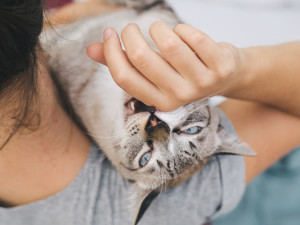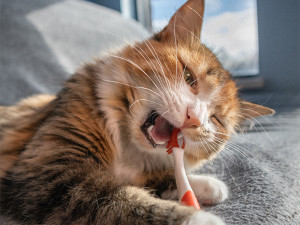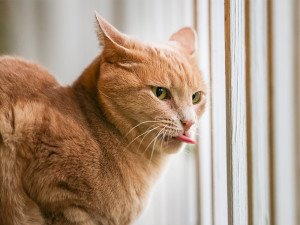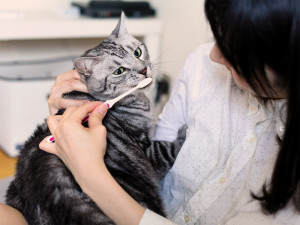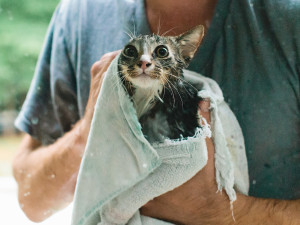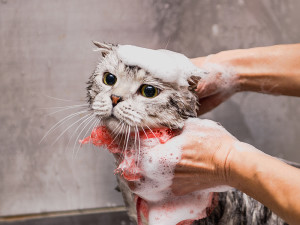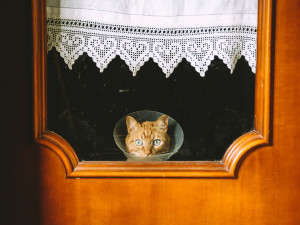How to Brush Your Cat’s Teeth
It sounds like a daunting task, but here are some helpful steps to take.
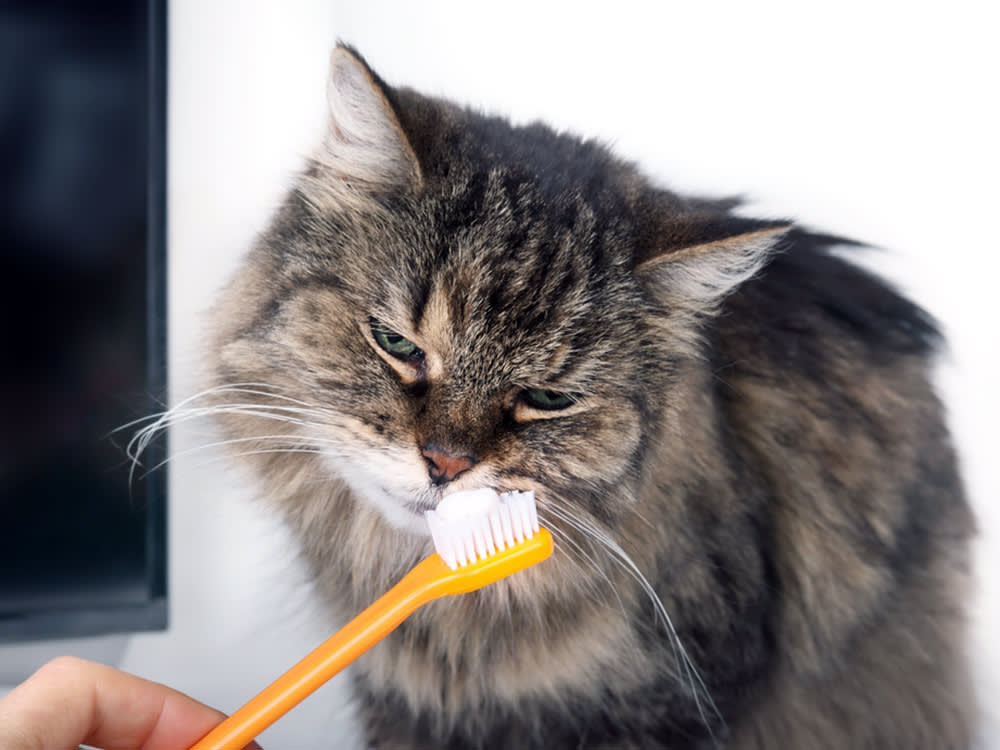
share article
In This Article:
Should You Brush Your Cat’s Teeth?opens in a new tab How Often Should You Brush Your Cat’s Teeth?opens in a new tab How to Brush Your Cat’s Teethopens in a new tab Additional Tools for Brushing Your Cat’s Teethopens in a new tab Additional Tips for Cat Dental Hygieneopens in a new tab When to Visit the Vet for a Dental Checkup opens in a new tab
Your cat’s pearly whites may not be your favorite thing when they’re sinking into your hand while they’re playing, but they are pretty important to their overall health. And, just like yours, they need consistent care and attention (even if they disagree with you).
Should you brush your cat’s teeth?
Yes, you should brush your cat’s teeth. Brushing your cat’s teeth is a proactive step toward ensuring their oral health. Start by introducing your cat to pet-safe toothpasteopens in a new tab, letting them taste it from your finger. As they grow comfortable, transition to a cat toothbrushopens in a new tab, using gentle circular motions to brush their teeth. This guide will walk you through the essential steps for effective and stress-free cat teeth brushing.
Dental disease is one of the most common health concerns in cats. In fact, almost all cats will have some form of dental disease by age three. Periodontal (gum) disease can have an enormous impact on a cat’s overall health and quality of life. Severe dental disease can result in:
Oral pain
Tooth loss
Weakening of the bones of the jaw and nasal cavity
Bacterial spread other organs like the heart and kidneys
Although it seems like an impossible task, as a cat parent you can and should brush your cat’s teeth. Toothbrushing significantly improves dental health in cats. It may be easier to introduce the idea to a kittenopens in a new tab, but with patience and proper supplies, some adult cats will allow it.
How often should you brush your cat’s teeth?
If you’re wondering how often to brush your cat’s teeth, the answer is daily. Even after a professional cleaning, plaque can start to reappear in a cat’s mouth within a day. This plaque will mineralize into visible tartar within two weeks. In addition to scheduling regular veterinary cleanings, pet parents should take a proactive approach to their cat’s dental health. This means taking preventative measures at home to minimize tartar formation.
How to brush your cat’s teeth
If you’re just starting dental care with an adult cat, begin with a veterinary check-up. If your cat already has significant dental disease, brushing may be painful and counterproductive. Your vet may recommend an initial professional cleaning, allowing for a clean slate before incorporating at-home brushing into the routine. Once you get the go-ahead, here are some tips to get started:
1. Gather your supplies.
You’ll need toothpaste and a toothbrush specifically for your cat. Do not use human toothpaste to brush your cat’s teeth. Human toothpaste is not made to be swallowed, and some products have ingredients that are toxic to cats. Skip the baking soda and coconut oil, too.
Choose a toothbrush small enough to fit in your cat’s mouth (a cat-specific toothbrush or a baby toothbrush). There are also over-the-finger toothbrushes that may allow for more control. But use caution — a cat can bite through these. When first starting, it’s fine to use a cotton swab to get them used to the motions.
2. Practice getting into your cat’s mouth.
Accessing your cat’s teeth is something for both you and your cat to get used to. Make sure the environment is calm and quiet. Find a position that allows you to best control your cat if they get a little squirmy, whether it's having your cat sit on your lap or on a firm surface with their back to you.
Practice gently raising your cat’s chin and lifting the lips to expose their teeth. You may need a buddy if your cat gets handsy and tries to paw your hand away. Reward your cat with treats or yummy cat toothpaste.
3. Gradually introduce the toothpaste and toothbrush to your cat.
Many cat toothpastes come in feline-friendly flavors like chicken or fish. Let your cat lick the toothpaste off your finger or the toothbrush. If they’re hesitant to taste it on their own, place a small dab on their nose for them to lick off.
Without toothpaste, brush the side of your cat’s face. Many cats will instinctively bite the toothbrush, helping to acclimate them to the sensation of the bristles on their teeth.
4. Introduce brushing slowly.
Use gentle circular motions. Start with the large canine teeth; they’re the easiest to access. Then, gradually move to the larger cheek teeth.
Good news: you only need to clean the side of the teeth touching the cheeks. Salivary enzymes and professional cleanings can take care of the inner surfaces.
5. Get into a routine.
Start with a goal of spending five to 10 seconds on each surface of the mouth: front, left, and right. Then slowly increase time until you’re able to brush each side for 30 seconds. While brushing your cat’s teeth every day is recommended, even three times a week can make a huge difference.
6. Be patient
Don’t rush through the steps if your cat is having a hard time. It may take several days before you work up to actually brushing a single tooth. And that’s OK.
Tools for brushing your cat’s teeth
Cat parents face many choices when it comes to gathering supplies for at-home dental care. If you’re overwhelmed and unsure where to start or the tools you tried aren’t working, seek guidance.
Ask your vet for recommendations.
Look for products approved by the Veterinary Oral Health Council (VOHC)opens in a new tab, a world-wide organization of veterinary dental health professionals who research the claims and efficacy of pet dental products.
Be open to a little trial and error to find what works for you and your cat.
Additional tips for cat dental hygiene
If you and your cat have reached the limits of patience with toothbrushing, know that you’re not alone. Brushing a cat’s teeth can be a challenge, and one that some cats won’t allow you to do safely. The important thing is to not ignore your cat’s dental healthopens in a new tab. While the mechanical scrubbing of toothbrushing is the optimal way to control plaque and tartar at home, there are alternative options including:
Dental diets
Dental treats
Water additives
Dental wipes
Oral sprays and gels
Anti-plaque powders
Explore alternatives until you find a suitable option that suits your cat's preferences and helps maintain their dental health.
When should you take your cat to the vet for dental concerns?
Regular exams and professional cleanings are a part of routine dental care, even in the absence of obvious dental problems. The goal is to maintain oral health before a cat experiences discomfort and infection. But despite best efforts, dental disease can still develop. Signs that you should take your cat the vet for dental concerns include:
Bad breath (especially if it appears suddenly)
Dropping food
Reluctance to eat
Teeth chattering
Oral discharge
Facial swelling
Pawing at the face/mouth
Common dental diseases in cats
Cats can be susceptible to various dental issues that, if left untreated, may lead to discomfort and more severe complications. Routine care and prevention are vital. Some of the most common dental diseases in cats include:
Gingivitis: Inflammation of the gums that results in redness and swelling. Gingivitis is an early stage of periodontal disease.
Periodontal (gum) disease: Inflammation and infection of the tissue supporting the teeth.
Tooth resorption: Progressive destruction of the hard layers of a tooth, resulting in erosion and tooth loss.
Stomatitis: Inflammation of the mucous membranes in the mouth, including the gums, tongue, and hard palate. Viral infections like feline herpesvirus, feline calicivirus, feline immunodeficiency virus (FIV)opens in a new tab, and feline leukemia virus FeLV) can contribute to the development of stomatitis.
FAQs (People also ask):
Are there any alternatives to teeth brushing for cats?
It is possible to help keep a cat's teeth clean without brushing. Alternatives to cat brushing include dental diets, treats, wipes, water additives, anti-plaque powders, and oral sprays and gels.
Are there recommended toothpastes for cats?
Cat parents should use only pet-safe toothpastesopens in a new tab to brush their cat’s teeth. Never use human toothpaste because many contain ingredients that are toxic to pets and should not be ingested.
What signs indicate it’s time to brush my cat’s teeth?
Because nearly all cats develop dental disease by age three, it's recommended to introduce toothbrushing early. If your cat is showing signs of dental infection like pain, anorexia, facial swelling, or oral discharge, seek veterinary attention.
References:

Dr. Alycia Washington, DVM, MS
Alycia Washington, DVM, is a small animal emergency veterinarian based in North Carolina. She works as a relief veterinarianopens in a new tab and provides services to numerous emergency and specialty hospitals. Dr. Washington is also a children’s book author and freelance writer with a focus on veterinary medicine. She has a special fondness for turtles, honey bees, and penguins — none of which she treats. In her free time, Dr. Washington enjoys travel, good food, and good enough coffee.
Related articles
![Young Asian woman brushing her cat's teeth.]() opens in a new tab
opens in a new tabThe Best Cat Toothpaste
You have to keep those pearly whites clean. Here are some suggestions for toothpaste that will do the trick.
![cat wrapped in towel after bath]() opens in a new tab
opens in a new tabSelf-Care Sunday for Cats
How to bathe a cat, step by step.
![Cat being washed by a groomer]() opens in a new tab
opens in a new tabDoes My Cat Need a Professional Groomer?
If you thought your cat was a self-cleaning evolutionary marvel, you’re not wrong but...
![Happy woman and cute cat playing with disco ball glitter confetti at home.]() opens in a new tab
opens in a new tabHow to Raise Your Cat Parenting Game in 2024
Make this new year a great one for your kitty.
![cat with cone after vet visit]() opens in a new tab
opens in a new tabDoctor’s Orders: Cat Vet Visits Are Essential
Get thy cat to a vet, even if it’s a struggle to get them out the door.
![Brown Labrador lifting front leg]() opens in a new tab
opens in a new tabHow to Get a Head Start on Your Pet’s Health
Spot lumps, limps, and lethargy early on.
